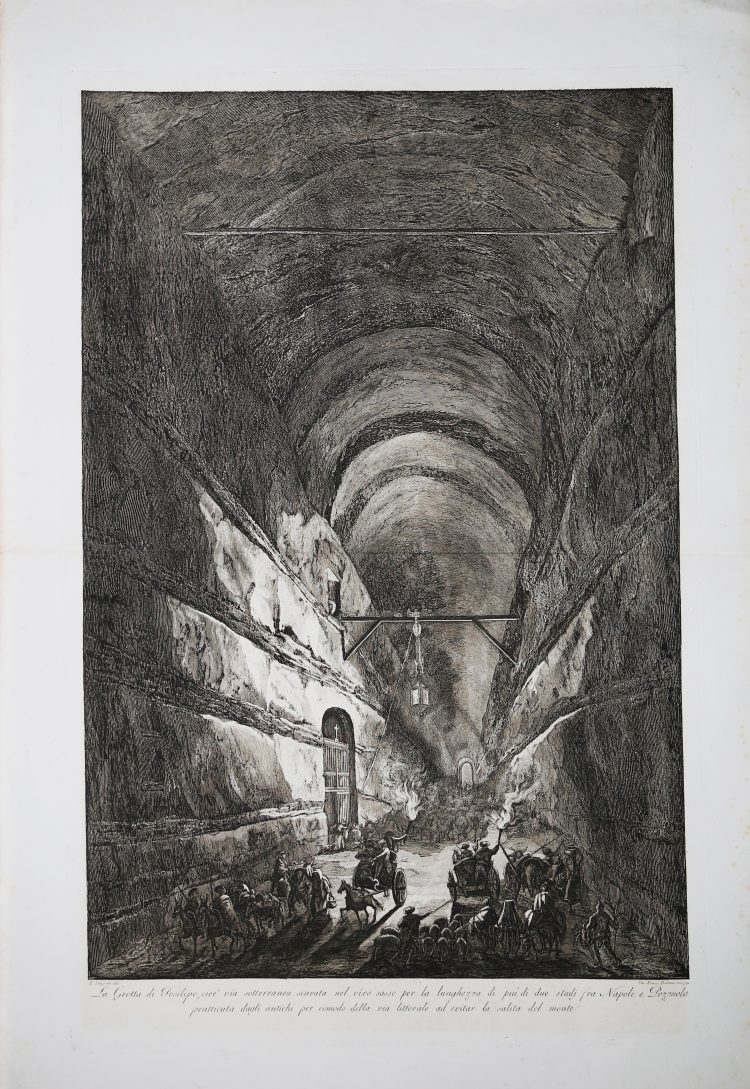



| Reference: | S46890 |
| Author | Francesco PIRANESI |
| Year: | 1791 |
| Measures: | 510 x 770 mm |


| Reference: | S46890 |
| Author | Francesco PIRANESI |
| Year: | 1791 |
| Measures: | 510 x 770 mm |
La Grotta di Posilipo, cioe' via sotterranea scavata nel vivo sasso per la lunghezza di piu' di due stadj fra Napoli e Pozzuolo pratticata dagli antichi per comodo della via littorale ad evitar la salita del monte.
View of the interior of the Grotto of Posilippo, Naples; subterranean passageway with figures and animals, two figures kneeling before another emerging from a gateway.
Etching, 1791, lettered with title and "L. Desprez del. / Cav. Franc. Piranesi inc. 1791".
Desprez's drawing is in the BM. This is a later state of the plate. The first state was in outline, etched by Piranesi as a base for Desprez to watercolour. After Desprez's departure from Italy, Piranesi reworked the plate so that it could be printed without needing to be coloured. The coloured ink with which the fire is printed is an afterthought of the original intention.
This is one of series of separately issued engravings of dramatically lit scenarios engraved and published by Francesco after drawings by the stage-designer Louis-Jean Desprez (1743-1804) - others include 'Il Santo Padre in adorazione nella Cappella Paolina in Vaticano' (1787), 'Prospetto interiore del Tempio Vaticano ...' (1787), qq.v., 'Fuoco artificiale detto la Girandola ...' [1788?], and a view of the eruption of Vesuvius in 1779. A pen-and-watercolour drawing by Desprez in the British Museum was probably the basis of this print, which was also issued by Francesco in an earlier, outline-etched state intended for hand-colouring.
The Roman tunnel linking Naples and Pozzuoli is also known as the Crypta Neapolitana. The Crypta Neapolitana (or Posillipo Cave or Virgil's Cave) is an approximately 711-meter-long tunnel carved into the tufa of Posillipo hill, between Mergellina (salita della Grotta) and Fuorigrotta (via della Grotta Vecchia), in Naples. It should not be confused with the Grotta di Seiano, another Roman tunnel that still crosses the Posillipo hill at its extreme offshoot. The cave's main entrance is on the Mergellina side, located inside the Vergiliano Park in Piedigrotta di Napoli, which also houses, among other things, the tomb of Giacomo Leopardi and the supposed tomb of Virgil.
A good impression on early 19th Century laid paper, full margins, very good conditions.
Bibliografia
Wollin 1933 / Gravure originales de Desprez ou executées d'après ses dessins (p.112(6)); Piranèse et les francais, 1740-1790, exhibition catalogue, ed. B. K. de Rola; Rome, Académie de France, 1976, pp. 121, 124-5, no. 60; Magnus Olausson, “Desprez et Piranèse fils: de l’original à la reproduction,” La Chimère de Monsieur Desprez, ed. Régis Michel, Paris, 1994, pp. 47-50.
Francesco PIRANESI (Roma 1758 - Parigi 1810)
|
Son of Giovanni Battista, and heir to his plates. Etcher and publisher in Rome; held office in the Roman Republic of 1798, and had to flee with all his plates to Paris in 1799, where he established (with his brothers Peter and Laura, also engravers), the Chalcographie Piranesi des Frères and a factory of terracotta of ancient models. Francesco (1758–1810), who played an important part in completing his father's later works, notably the Vasi…Francesco Piranesi published a map of the Villa Adriana, Tivoli (1781), and added new plates to further editions of the Vedute, Antichità, and other works. Most importantly, he issued a massive collection of graphic works in 27 volumes (1800–7) as well as a three-volume set of Antiquités de la Grande Grèce (1804–7) based on his father's work at Pompeii.
|
Francesco PIRANESI (Roma 1758 - Parigi 1810)
|
Son of Giovanni Battista, and heir to his plates. Etcher and publisher in Rome; held office in the Roman Republic of 1798, and had to flee with all his plates to Paris in 1799, where he established (with his brothers Peter and Laura, also engravers), the Chalcographie Piranesi des Frères and a factory of terracotta of ancient models. Francesco (1758–1810), who played an important part in completing his father's later works, notably the Vasi…Francesco Piranesi published a map of the Villa Adriana, Tivoli (1781), and added new plates to further editions of the Vedute, Antichità, and other works. Most importantly, he issued a massive collection of graphic works in 27 volumes (1800–7) as well as a three-volume set of Antiquités de la Grande Grèce (1804–7) based on his father's work at Pompeii.
|